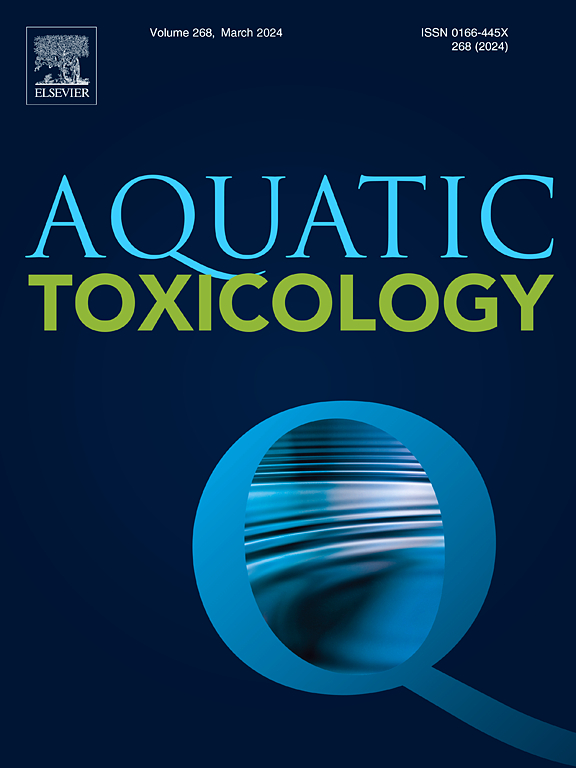Aryl phosphate ester-induced pericardial edema in zebrafish embryos is influenced by the ionic composition of exposure media
IF 4.1
2区 环境科学与生态学
Q1 MARINE & FRESHWATER BIOLOGY
引用次数: 0
Abstract
Pericardial edema – fluid accumulation within the pericardium – is a frequently observed malformation in zebrafish embryo-based chemical toxicity screens. We recently discovered that the severity of triphenyl phosphate (TPHP)-induced pericardial edema was dependent on the ionic strength of exposure media. TPHP is an aryl phosphate ester (APE) widely used as a plasticizer and flame retardant. APEs are characterized by having one or more aryl groups bound to a phosphate center, with TPHP containing only unsubstituted aryl groups. Therefore, the objective of this study was to begin investigating whether, similar to TPHP, pericardial edema induced by other structurally related APEs is dependent on the ionic composition of exposure media. We first mined the peer-reviewed literature to identify other APEs that 1) induced pericardial edema in zebrafish embryos within a minimum of three peer-reviewed publications, and 2) demonstrated a statistically significant induction of pericardial edema in at least 70 % of the studies evaluated. Based on this meta-analysis, we identified four other APEs that caused pericardial edema in zebrafish embryos: isopropylated triphenyl phosphate (IPTPP), cresyl diphenyl phosphate (CDP), tricresyl phosphate (TMPP), and 2-ethylhexyl diphenyl phosphate (EDHPHP). Using TPHP as a positive control and pericardial edema as a readout, we developed concentration-response curves for all four APEs based on static exposure from 24 to 72 h post-fertilization (hpf). We then conducted co-exposures with D-Mannitol (an osmotic diuretic) and exposures within reverse osmosis (RO) water determine whether the ionic composition of exposure media mitigated APE-induced pericardial edema at 72 hpf. Using pericardial edema as an endpoint, the approximate EC50s for TPHP (positive control), IPTPP, CDP, TMPP, and EDHPHP were 6.25, 3.125, 3.125, 25, and 100 µM, respectively, based on exposure from 24 to 72 hpf. Interestingly, similar to our findings with TPHP, co-exposure with D-Mannitol and exposure within ion-deficient water significantly mitigated IPTPP- CDP-, TMPP-, and EDHPHP-induced pericardial edema in zebrafish embryos, suggesting that chemically-induced pericardial edema may be 1) dependent on the ionic composition of exposure media and 2) driven by a disruption in osmoregulation across the embryonic epidermis. Therefore, similar to other assay parameters, our findings underscore the need to standardize the osmolarity of exposure media in order to minimize the potential for false positive/negative hits in zebrafish embryo-based chemical toxicity screens conducted around the world.
磷酸芳基酯诱导的斑马鱼胚胎心包水肿受接触介质离子成分的影响
心包水肿(心包内液体积聚)是斑马鱼胚胎化学毒性筛选中经常观察到的一种畸形。我们最近发现,磷酸三苯酯(TPHP)诱发心包水肿的严重程度取决于暴露介质的离子强度。磷酸三苯酯是一种芳基磷酸酯(APE),被广泛用作增塑剂和阻燃剂。APE 的特点是有一个或多个芳基与磷酸中心结合,而 TPHP 只含有未取代的芳基。因此,本研究的目的是开始调查与 TPHP 类似,其他结构相关的 APE 所诱发的心包水肿是否取决于接触介质的离子成分。我们首先对同行评议文献进行了挖掘,以确定其他 APE:1)在至少三篇同行评议出版物中诱发斑马鱼胚胎心包水肿;2)在至少 70% 的评估研究中显示出统计学意义上的心包水肿诱导。根据这项荟萃分析,我们确定了另外四种会导致斑马鱼胚胎心包水肿的 APE:异丙基化磷酸三苯酯(IPTPP)、磷酸甲酚二苯酯(CDP)、磷酸三甲苯酯(TMPP)和磷酸二苯乙酯(EDHPHP)。以 TPHP 为阳性对照,以心包水肿为读数,我们根据受精后 24 至 72 小时(hpf)的静态暴露,绘制了所有四种 APE 的浓度-反应曲线。然后,我们用 D-甘露醇(一种渗透性利尿剂)进行了联合暴露,并在反渗透(RO)水中进行了暴露,以确定暴露介质的离子成分是否能减轻 APE 在 72 hpf 诱导的心包水肿。以心包水肿为终点,根据 24 至 72 hpf 的暴露,TPHP(阳性对照)、IPTPP、CDP、TMPP 和 EDHPHP 的 EC50 值分别为 6.25、3.125、3.125、25 和 100 µM。有趣的是,与我们对 TPHP 的研究结果类似,在斑马鱼胚胎中同时暴露于 D-甘露醇和离子缺乏的水中可显著减轻 IPTPP-CDP-、TMPP- 和 EDHPHP 诱导的心包水肿,这表明化学诱导的心包水肿可能 1) 取决于暴露介质的离子组成,2) 由整个胚胎表皮的渗透调节紊乱驱动。因此,与其他检测参数类似,我们的研究结果也强调有必要对暴露介质的渗透压进行标准化,以尽量减少世界各地基于斑马鱼胚胎的化学毒性筛选中出现假阳性/阴性结果的可能性。
本文章由计算机程序翻译,如有差异,请以英文原文为准。
求助全文
约1分钟内获得全文
求助全文
来源期刊

Aquatic Toxicology
环境科学-毒理学
CiteScore
7.10
自引率
4.40%
发文量
250
审稿时长
56 days
期刊介绍:
Aquatic Toxicology publishes significant contributions that increase the understanding of the impact of harmful substances (including natural and synthetic chemicals) on aquatic organisms and ecosystems.
Aquatic Toxicology considers both laboratory and field studies with a focus on marine/ freshwater environments. We strive to attract high quality original scientific papers, critical reviews and expert opinion papers in the following areas: Effects of harmful substances on molecular, cellular, sub-organismal, organismal, population, community, and ecosystem level; Toxic Mechanisms; Genetic disturbances, transgenerational effects, behavioral and adaptive responses; Impacts of harmful substances on structure, function of and services provided by aquatic ecosystems; Mixture toxicity assessment; Statistical approaches to predict exposure to and hazards of contaminants
The journal also considers manuscripts in other areas, such as the development of innovative concepts, approaches, and methodologies, which promote the wider application of toxicological datasets to the protection of aquatic environments and inform ecological risk assessments and decision making by relevant authorities.
 求助内容:
求助内容: 应助结果提醒方式:
应助结果提醒方式:


